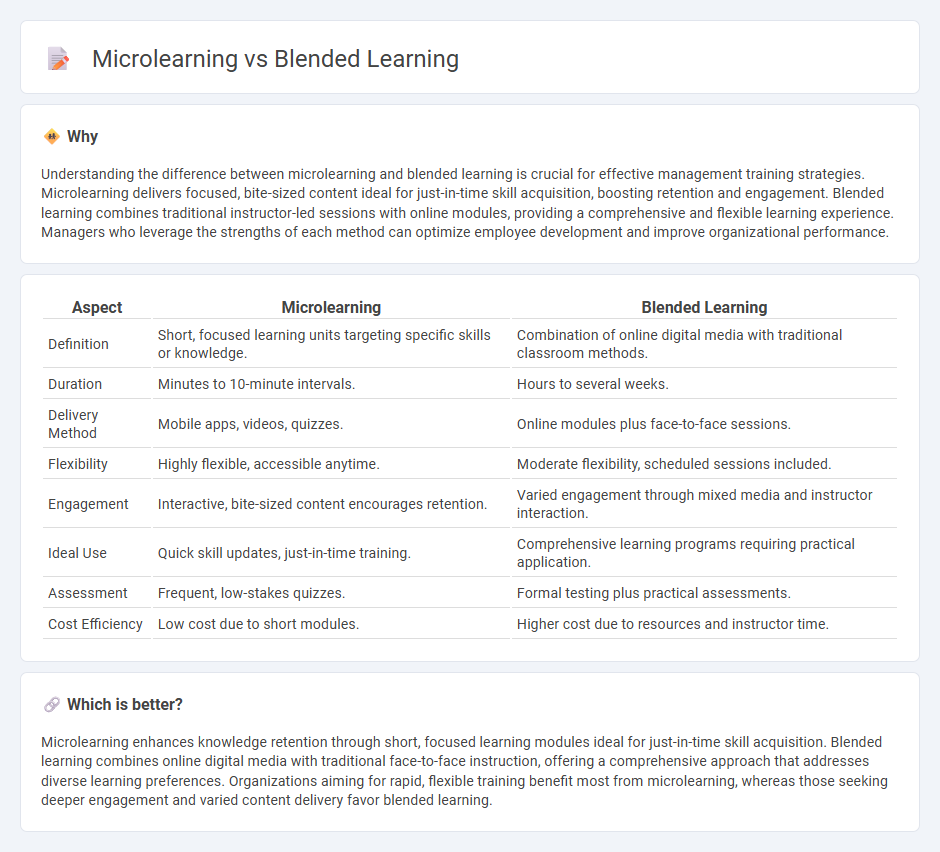
Microlearning delivers focused, bite-sized educational content ideal for quick skill acquisition and knowledge retention, while blended learning combines online digital media with traditional classroom methods to enhance learner engagement and flexibility. Both approaches cater to diverse learning preferences and organizational goals, optimizing training effectiveness and employee development. Discover how integrating these strategies can transform your management training programs.
Why it is important
Understanding the difference between microlearning and blended learning is crucial for effective management training strategies. Microlearning delivers focused, bite-sized content ideal for just-in-time skill acquisition, boosting retention and engagement. Blended learning combines traditional instructor-led sessions with online modules, providing a comprehensive and flexible learning experience. Managers who leverage the strengths of each method can optimize employee development and improve organizational performance.
Comparison Table
| Aspect | Microlearning | Blended Learning |
|---|---|---|
| Definition | Short, focused learning units targeting specific skills or knowledge. | Combination of online digital media with traditional classroom methods. |
| Duration | Minutes to 10-minute intervals. | Hours to several weeks. |
| Delivery Method | Mobile apps, videos, quizzes. | Online modules plus face-to-face sessions. |
| Flexibility | Highly flexible, accessible anytime. | Moderate flexibility, scheduled sessions included. |
| Engagement | Interactive, bite-sized content encourages retention. | Varied engagement through mixed media and instructor interaction. |
| Ideal Use | Quick skill updates, just-in-time training. | Comprehensive learning programs requiring practical application. |
| Assessment | Frequent, low-stakes quizzes. | Formal testing plus practical assessments. |
| Cost Efficiency | Low cost due to short modules. | Higher cost due to resources and instructor time. |
Which is better?
Microlearning enhances knowledge retention through short, focused learning modules ideal for just-in-time skill acquisition. Blended learning combines online digital media with traditional face-to-face instruction, offering a comprehensive approach that addresses diverse learning preferences. Organizations aiming for rapid, flexible training benefit most from microlearning, whereas those seeking deeper engagement and varied content delivery favor blended learning.
Connection
Microlearning enhances blended learning by delivering targeted, bite-sized content that complements traditional face-to-face instruction, improving knowledge retention and learner engagement. Blended learning integrates various instructional methods, combining online microlearning modules with classroom activities to create a flexible and effective learning environment. Together, they optimize management training programs by facilitating continuous skill development and accommodating diverse learning preferences.
Key Terms
Delivery Method
Blended learning combines traditional face-to-face instruction with online digital content, allowing for a flexible, interactive, and comprehensive delivery method that caters to diverse learning styles. Microlearning delivers content in short, focused bursts, typically through mobile devices, optimizing retention and engagement by addressing specific learning objectives quickly. Explore how these different delivery methods can transform your training effectiveness and engagement strategies.
Content Length
Blended learning typically involves longer content sessions combining online and face-to-face instruction, facilitating comprehensive topic coverage and deeper understanding. Microlearning delivers shorter, focused modules designed for rapid consumption and quick retention, ideal for just-in-time training. Explore more to determine which content length strategy best suits your educational goals.
Learner Autonomy
Blended learning combines traditional classroom methods with digital tools, enhancing learner autonomy by allowing students to control the pace and access to diverse learning materials. Microlearning focuses on delivering bite-sized, targeted content that fosters self-directed learning and immediate knowledge application, promoting greater independence. Explore more to understand which approach best improves learner autonomy in various educational settings.
Source and External Links
What is Blended Learning? Examples & More - Blended learning is an instructional approach combining digital or online learning materials and activities with traditional face-to-face classroom methods, allowing personalized and flexible learning experiences.
5 Blended Learning Strategies to Try in Middle and High School - Blended learning integrates online learning with supervised in-person education, giving students control over time, place, path, and pace, supported by data-driven and personalized instruction.
Rethinking the Classroom for Blended Learning | NEA - Blended learning merges virtual and face-to-face environments, with students controlling place, path, and pace of learning, involving pre-learning, instructor-led sessions, and evaluative post-learning activities.
 dowidth.com
dowidth.com